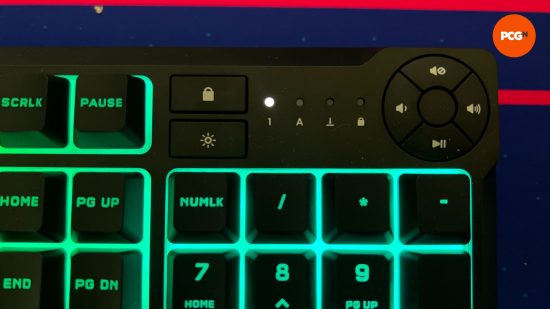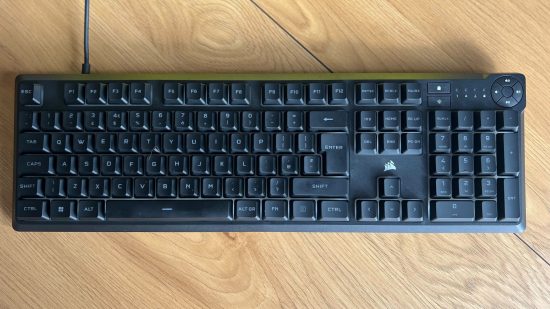Our Verdict
The Corsair K55 is a good budget gaming keyboard that doesn’t complicate its simple design and has an appealing price to match. It won’t compete with mechanical, magnetic, or optical keyboards on responsiveness or performance, but it’s not trying to. Instead, it is an approachable gateway peripheral for those looking to make a start with the easy programmability, RGB lighting fun, and software integration available from an established brand.
- Incredible value
- Build quality is very solid
- Media keys and iCUE compatibility
- Non-removable rubber cable
- Loud to type and game with
- Keyswitches won’t last as long as mechanical ones
I wouldn’t blame anyone for shuddering at the term ‘budget gaming keyboard’, purely due to how it inspires thoughts of a product that is cheap while still somehow being not worth the investment. However, the Corsair K55 Core is a surprising budget option that is very cut-and-dry but is still worthy of a look, provided you temper your expectations.
The Corsair K55 Core is easily the best gaming keyboard on a budget I’ve used, and while it isn’t perfect for everyone, those with tighter purse strings will find plenty here to appreciate, as long as you’re aware of the downfalls versus a mechanical alternative.
Why you can trust our advice ✔ At PCGamesN, our experts spend hours testing hardware and reviewing games and VPNs. We share honest, unbiased opinions to help you buy the best. Find out how we test.

Corsair K55 Core features
The Corsair K55 Core comes with Windows, Mac, Xbox, and PlayStation compatibility out of the box, all via a wired connection. Its polling rate is set at 1,000Hz while the weight comes in at around 760g including the cable, which is unfortunately a ‘tangle-free rubber’ rather than braided, so you don’t get the extra protection the braiding provides. This is particularly notable given the cable isn’t removable so can’t easily be swapped if damaged.
In line with many of Corsair’s peripherals, the K55 Core is compatible with its iCUE software, allowing you to adjust the 10 RGB zones however you please. There are also six macro keys for you to create assignments for, and the K55 Core has onboard memory, meaning you won’t have to rely on having iCUEe open all the time for your customizations to be live.
The Corsair K55 Core is a full-size gaming keyboard, offering 110 keys and multimedia buttons that sit in the top right corner, providing convenient play/pause, track forward/back, and volume up/down control. There’s also a Windows key lock button here, for turning off the Windows key when gaming. Alongside these are four LEDs, three of which indicate the Lock key (Caps, Num, Scroll) status while the fourth shows when the Windows key has been disabled.
Finally, the Corsair K55 Core is spill-resistant up to 300ml, which hopefully is something you will never need to put to the test, but it’s nice to have in a worst-case scenario.

Corsair K55 Core design
The K55 Core is a smart-looking keyboard. Its frame is a basic black plastic but there’s a certain simplicity that’s more appealing than the many more outlandish designs gaming peripherals come in. The RGB is a nice inclusion too and not a complete afterthought as it often tends to be in cheaper boards. Thanks to the iCUE compatibility, you have full control over 10 different zones and can either create your own patterns or select from the list of presets.
The board has adjustable feet, allowing you to adjust its angle, but unlike some boards, you only get the two options: flat or slightly raised at the back. There is very little flex to the board, which is a sign of strong build quality, and no matter how heavy-handed I allowed myself to be when typing or gaming, it held up.

Corsair K55 performance
When it comes to performance on the Corsair K55 Core, I have to start with the 12 key rollover (12 KRO) limit, which is the biggest drawback of this board. This means that if you develop a fast typing pace, or play games that require multiple simultaneous key inputs, you could be facing an issue where the K55 Core doesn’t register all the inputs properly.
As a gaming keyboard, this could seem like a fairly fatal flaw, but a limit of 12 keys at once is unlikely to interfere with most gameplay and typing situations – most of us only have ten fingers, after all. During my testing, I didn’t encounter any dropped key inputs, though there’s always the chance you may encounter this limitation and so will require an n-key rollover keyboard where every key press is always registered.
Regarding the membrane switches, there is a fair amount of force required to activate each key, and then a very sudden drop through to the complete press. This is a typical membrane keyboard feel, and the smoother movement of mechanical/optical/magnetic switches is one of the reasons many people consider them a must-have for anything above an entry-level board. Even if you like clicky or tactile feedback keys, mechanical switches still tend to be far smoother and less effort to press than membrane ones.
That being said, when I got into the rhythm of using the K55 Core, rarely did I find it had a negative impact on my gaming experience. Beyond some overly glossy keys that can become a little slippery, the general feel of gaming and typing with the K55 Core is admirable for such a cheap product.
Instead, the other main drawback that will likely come to the fore over time is that membrane keyboards tend to wear out much quicker than mechanical boards. With heavy use we’ve encountered boards that can noticeably start to feel less responsive – keypresses don’t register – after only a year or so of use. But, to get that extra longevity, you’ll have to pay more or lose features at a similar price.
As mentioned earlier, there’s no flex to be felt when typing or gaming and despite a slightly grating typing sound that is hollow and very loud, that came and went in how much it bothered me, I really can’t find fault with the K55 Core without unfairly comparing it to products that cost at least 3x as much.

Corsair Core K55 conclusion
The Corsair K55 Core is a great budget membrane gaming keyboard. It’s hard to sell it to anyone who has experienced the benefits of high-end features like adjustable actuation, rapid trigger, or just the feel of mechanical switches, but Corsair isn’t appealing to this market with the K55 Core.
Instead, this is purely a gaming keyboard that is great for a younger or more inexperienced audience who is just getting into PC gaming, with the additional benefit of offering a decent enough typing experience and plenty of basic gaming programmability options via Corsair iCUE.
For $39.99 (£39.99), it’s impressive how much Corsair has packed into the K55 Core, all while keeping it relatively quiet too.
Alternatives
SteelSeries Apex 3
If you’re keen for some added comfort and protection while still sticking with membrane switches, the SteelSeries Apex 3 comes with a premium magnetic wrist rest and is IP32 water and dust-resistant, because we’ve all been guilty of spilling our mountain dew while raging in the CoD lobbies.
The Apex 3 also has full integration with SteelSeries GG, allowing for some special RGB effects for games and apps like Minecraft and Discord.
Royal Kludge RK920
Royal Kludge is one of the more reliable names in budget mechanical keyboards and the RK920 offers a full-size keyboard with RGB lighting for just $40. You don’t get multimedia keys or the software programmability and RGB light syncing of the K55 Core but the raw typing experience will be better.
